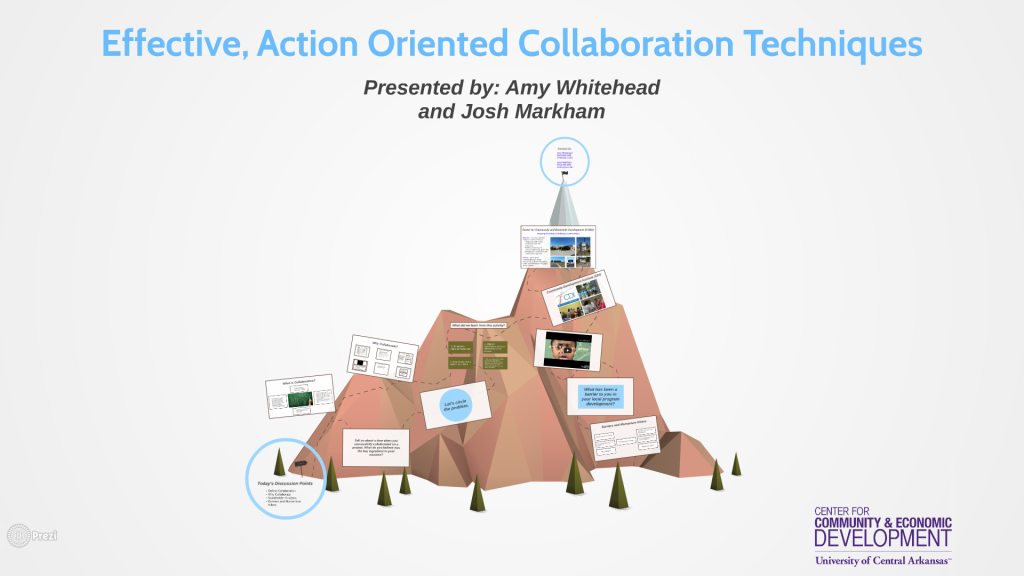Welcome to the Center of Community and Economic Development blog, the state’s first community and economic development blog!
Building Stronger Communities Through Regionalism
How collaboration and shared resources are shaping the future of local development.
By Tracie Spivey
This article was originally posted in ARML City & Town magazine.
In today’s interconnected world, success often requires looking beyond city limits. This is especially true in rural areas. Regionalism transcends these city boundaries, offering a strategic path to rural development. By fostering collaboration among governments, businesses, and residents across a geographic area, this approach leverages collective strengths to tackle shared challenges. Through pooling resources, exchanging ideas, and creating opportunities, communities are able to maximize their efficiency and impact while sparking innovative solutions through expanding economic and social prospects. The end goal is to create cohesive, resilient communities by focusing on shared benefits and sustainable progress.
Expert Insight: Why Regionalism Matters
Matt Twyford, Community Development Director for the Arkansas Economic Development Commission, said, “Regionalism is crucial, particularly for rural areas. By working together, communities can share knowledge and resources to overcome challenges more effectively. This collective approach leads to stronger localities and a stronger state overall.”
A shining example is the Northeast Arkansas Intermodal Authority, where four counties pooled resources to attract economic opportunities. Their collaborative efforts led to significant successes, including G&H Decoys relocating to Corning, Provalus expanding in Walnut Ridge, and Tate Industries selecting Pocahontas for a manufacturing site.
These projects are part of a broader economic development initiative that has delivered substantial results. In 2024 alone, three state-backed projects—Tate, Provalus, and G&H Decoys—created 425 new jobs with an average hourly wage of $23.04, driven by more than $30 million in outside investment and $6.6 million in grant funding for job creation, infrastructure, and workforce development.
Over the past five years (2020-2024), the region has seen four major state-backed projects, including Emerson, bringing a combined 1,042 net new jobs, over $70 million in outside investment, and $43 million in grant funding support. This momentum was further bolstered by the I-57 designation and interstate groundbreaking, marking a transformative milestone for future growth and connectivity.
Pike County: Regionalism in Action
Pike County offers a compelling example of regional collaboration in Arkansas. Leaders from Murfreesboro and Glenwood recently joined forces to organize a countywide tour showcasing the area’s tourism potential. They invited a diverse group of statewide leaders and experts, including representatives from the Arkansas Department of Tourism, Arkansas Economic Development Commission, University of Central Arkansas, State Representative Justin Gonzales, Glenwood Revitalization Group, Glenwood Chamber of Commerce, Murfreesboro Chamber of Commerce, Visit Hot Springs, Hot Springs Regional Chamber of Commerce, and Pike County Judge Eddie Howard.
This initiative provided an opportunity for participants to experience firsthand how regional cooperation is driving transformation in Pike County, paving the way for economic growth and community revitalization.
Tourism as a Driver
The tour focused on how Pike County communities are working together to position tourism as a shared growth avenue, using examples such as:
- Crater of Diamonds State Park: This one-of-a-kind destination draws visitors from around the globe, offering them the chance to dig for diamonds and keep what they find.
- Swaha Lodge and Marina: Nestled on Lake Greeson, this retreat combines stunning views with opportunities for fishing, boating, and relaxation.
- Downtown Glenwood Revitalization: Funded by Community Development Block Grants (CDBG), efforts to enhance historic architecture and reduce blight are reinvigorating this charming town.
- Tranquil Lane: This scenic stretch by the Caddo River features properties blending residential and rental potential, adding to the region’s allure.
- Glenwood Iron Mountain Railroad Depot: The depot, relocated from its original site, was nominated to the National Register along with other railroad-related structures statewide. It now houses the Glenwood Chamber of Commerce, representing typical small-town depots in western Arkansas.
Leaders in Murfreesboro and Glenwood are actively pursuing initiatives to boost year-round tourism, enhance accommodations, and introduce expanded amenities like alcohol sales. These efforts aim to strengthen Pike County’s appeal as a destination while fostering a sense of unity.
Ki Heartsfield, Executive Vice President of Southern Bancorp and founding member of Glenwood Revitalization Group, reflected on the experience, “We had the opportunity to showcase the many great things that Pike County has going for it. The VIP tour gave us a chance to shed a light on the treasure that our county is. From the Diamond mine, to Lake Greeson, to the Caddo River; tourism is a bright spot in our local economy. We have a lot to offer our tourists and locals alike and we believe this tour gave us an occasion to show why we believe Pike County ia a great place to visit and live.”
Looking Ahead
Regionalism isn’t just about shared challenges; it’s about shared opportunities. By embracing this approach, communities like those in Pike County are creating a foundation for sustainable growth, cultural preservation, and economic resilience. As Twyford aptly put it, “Together, we’re stronger.”
For towns across Arkansas and beyond, regionalism offers a blueprint for thriving in an increasingly interconnected world—proof that collaboration isn’t just a strategy; it’s a necessity.







